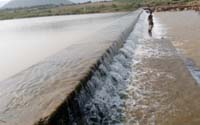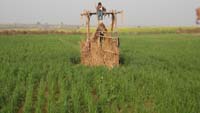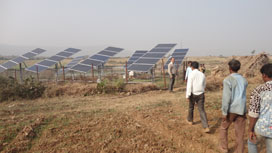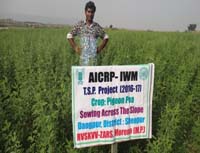Madhya Pradesh state has a high proportion of schedule tribe population (23 % of total tribal population) in the country. The state is inhabited by the Gonds, Mariya, Bhil, Bhilala, Saharia and Kaul tribes. The Saharia tribal village Dangpura under Chetikhera panchayat of Vijaypur tehsil has 62 Saharia tribal families’ with total population of 415. Out of total 28.8 ha area of the village 26 ha is cultivated area. The entire village is inhabited by the marginal land holders in undulated topography and only 8% of agricultural land was irrigated through small diesel engine. Due to poor economic conditions of Sahariya tribal farmers, diesel powered irrigation was a costly venture for them. The average annual rainfall in the area is 750 mm which mostly occurs in the months of July and August. The climate of the region is also extremist i.e. extreme minimum (2° C) and maximum (49° C) temperature, dry spell (mid and late season). The average agricultural productivity of the village is only half of the district average. All the village households are below poverty line and earn their livelihoods through collection and selling of minor forest produces and rainfed agriculture. The overall average monthly household income varied between Rs. 1500 to 2000.
Due to scarcity of water for domestic use, animal rearing and agriculture activities, a small stop dam was constructed on Kuwari Rivulet by the district administration. The stop dam became defunct due to poor water storage and unavailability of water lifting system.
Scientists from ICAR-AICRP on Irrigation Water Management, Morena, and ICAR- Indian Institute of Water Management, Bhubaneshwar visited Dangpura for planning of irrigation development in the village to improve agro based livelihoods under Tribal Sub Plan component scheme.
As the stop dam constructed could not hold much water for water lifting, it was proposed by the team to increase the height of the stop dam by another 1.5 meters to increase the water level. It was also planned to install a community based solar water lifting system for irrigating the cultivable lands under TSP component scheme. Accordingly, a community based solar lift irrigation system was installed near the stop dam. The stored water is lifted through solar powered submersible pump as no electricity was available in the area. The system generates 10000 watts electricity through 40 solar panels (each panel of 250 watts) fitted for running of floating submersible pump. The water pumping capacity of 10 hp submersible floating pump is about 50,000 litres/hour. Simultaneously, irrigation pipeline was laid in 26 ha of land covering 62 tribal families with one outlet for each 4 acres of land for minimising conveyance and application losses of water. Provision has also been made for drip and sprinkler irrigation in about 4.0 ha of land for rabi vegetable cultivation.





After installation of the solar based lift irrigation system, the whole domestic need and irrigation network, smooth operation system was handed over to the registered group of tribal water user farmers who have created a revolving fund bank account through contributions by the members for operation and maintenance of the system. Trainings on improved irrigation and technologies on crop production, water use efficiency through lift irrigation system have been undertaken for users.
These farmers grow pigeonpea, greengram, sesame, pearlmillet in kharif, wheat, mustard, chickpea, and vegetable crops in rabi and greengram in summer season. Before installation of solar system the area of greengram, sesame, pearlmillet was only 19.5ha, whereas limited area of wheat, mustard, chickpea grown in 5.0ha due to rainfed, respectively. Impact on yield increased of kharif crops such as greengram, sesame, pearlmillet was by 39 to 92% and wheat, mustard, chickpea of 10 to 108%, respectively compared with crop grown before solar irrigation system. The net income from agricultural crops only Rs. 6165/year/family before intervention of irrigation, while it was increased Rs. 32,440/year/household with improved cropping intensity and productivity. The overal net income of 62 family income of group Rs. 3,82,265/year before intervention and it was increased after instalation of system Rs. 20,11,329/year from agricultural crops. Similarly the whole benefit cost ratio of crops was 1.8 before installation and 2.9 after installation, like-wise cropping intensity was also increased from 101 to 205%, respectively. The system also generated employment to the tune of 2248 man-days/year compared with before instalation of solar irrigation system was 1161 man-days/year from agricultural crops which resulted in reduction of migration to the nearby cities. The other advantage of the community based solar lift system is eco-friendly, cleaner and greener option of irrigation, no expenditure on fuel and low maintenance cost. Working expenditure is comparatively less as compared to electric motor and diesel engine. This system saved energy, time and labour. Thus the tribal community will be able to generate higher income and raise their living standard by diversified agriculture production.The impact of lift irrigation system is immense and proved boon for the poor tribal farmers.
(Source: ICAR-AICRP-Irrigation Water Management, Moren, Madhya Pradesh)







फेसबुक पर लाइक करें
यूट्यूब पर सदस्यता लें
X पर फॉलो करना X
इंस्टाग्राम पर लाइक करें